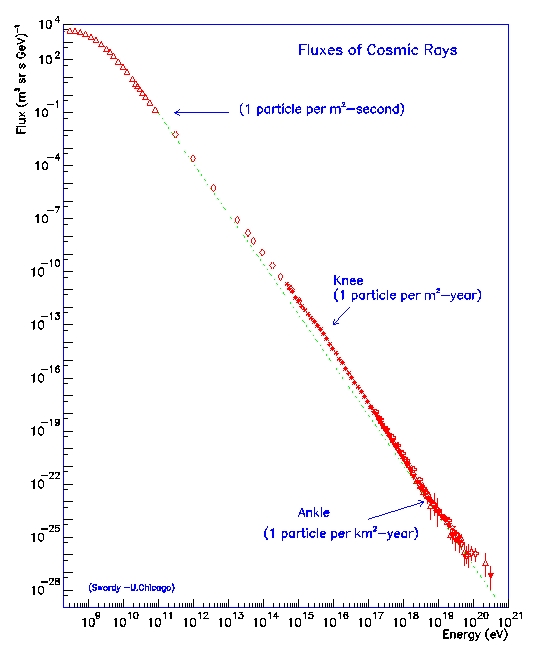Cosmic Rays: high energy particles from the Universe
What is an energetic particle?
In our everyday life we measure energies in units of a Joule. More familiar is the unit of a Watt. It measures a power, which means the energy consumed per unit time. But these units are not convenient when we talk about elementary particles with tiny masses such as protons and electrons.
Particle physicists and cosmic ray physicists measure energies in electron Volt (eV). 1 eV is the energy gained by an electron or a proton that is exposed to a voltage of 1 Volt. For instance, if we had a battery of 4.5 V in vacuum, and put a proton between its poles, the proton would be accelerated by the voltage of the battery and acquire an energy of 4.5 eV.
This is not a very high energy. The electrons and protons in the hot solar corona, where the temperature is about 1 million degrees, have an average energy of 100 eV. But when we talk about cosmic rays, much higher energies are involved. In order to be detectable on the ground, cosmic rays impinging on the top of the Earth's atmosphere must have a minimum energy of about 450 million eV (abbreviation: 450 MeV for Mega electron Volt).
Cosmic rays
 Cosmic rays impinging on the Earth have been counted, and we know their energy spectrum from different measurements.
This Figure shows a compilation of observations over a wide range of particle energies
(from http://astroparticle.uchicago.edu/cosmic_ray_spectrum_picture.htm).
The highest energy cosmic rays that have been detected have an energy above 100 billions of billions of eV
(1020 eV)!
This is the energy of a tennis ball launched at 100 km/h,
but in the case of very high energy cosmic rays, it is concentrated in a tiny proton!
Cosmic rays impinging on the Earth have been counted, and we know their energy spectrum from different measurements.
This Figure shows a compilation of observations over a wide range of particle energies
(from http://astroparticle.uchicago.edu/cosmic_ray_spectrum_picture.htm).
The highest energy cosmic rays that have been detected have an energy above 100 billions of billions of eV
(1020 eV)!
This is the energy of a tennis ball launched at 100 km/h,
but in the case of very high energy cosmic rays, it is concentrated in a tiny proton!
These particles have different origins:
Cosmic rays at energies up to a few billions of eV (109) eV, abbreviation: GeV=Giga electron Volt) come from the Sun and other sources in our Galaxy. The spectrum is curved in this region, because the access to the inner solar system of the cosmic rays coming from outside the solar system is reduced by the action of the Sun's magnetic field.
The permanent flux of cosmic rays does not come from the Sun, but from sources in our Galaxy or even beyond. At energies well above 10 GeV their access to the inner solar system is not affected by the solar magnetic field. These particles have a spectrum that is practically a straight line in this plot. Since the plot represents the logarithm of the particle flux as a function of the logarithm of the particle energy, the spectrum is in fact a power law in energy: F(E) ~E-p
Upon closer inspection, one notes that there are breaks in the power law, for instance near 3 x 1015 eV (this is called the knee of the cosmic ray spectrum) and near 1020 eV (the ankle). These features probably distinguish cosmic rays of different origins. Protons at energies well above 1015 eV and ions above 1018 eV are thought to come from outside our Galaxy.